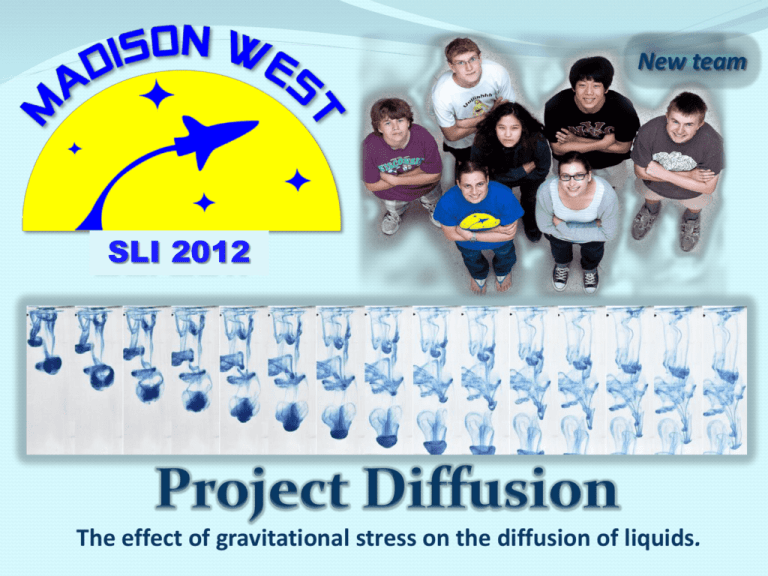CDP_MadisonWest2012_Diffusion
advertisement

New team SLI 2012 The effect of gravitational stress on the diffusion of liquids. February 17 Full scale vehicle completed February 18 Full scale test flight #1 March 24/25 Full scale test flight #2 with payload April 19/20 Flight hardware and safety checks April 21 Launch day, full scale fight #3 April 28/29 Full scale flight #4 (tentative) Coast Event 3: Apogee at 17s, 5252ft Drogue descent Event 2: Burnout at 2.24s, 1000ft Apogee prediction updated based on data from scale model flight (Cd=0.48): 5252ft Event 1: Ignition at 0s, 0ft Event 4: Main parachute deployment at 84s, 700ft Event 5: Landing at 110s, 0ft • Motor ignition • Stable flight • Altitude of 5,280 feet AGL reached but not exceeded (most current prediction: 5252ft) • Both drogue and main parachute deployed • Vehicle returns to the ground safely with minimal damage • Safe recovery of the booster CP CG Static margin Length Diameter Liftoff Weight Motor 83.1” from nosecone 65.6” from nosecone 3.2 calibers 108” 5.5”(body tube), 4”(booster) 21.5 lb Aerotech K1050W Letter Part A Nosecone B Main Parachute C Drogue Parachute D Payload Bay E Transition F Motor Mount G Fins • • • • • • • • Body: 5.5”/4.0” LOC Precision fiber tubing Fins: 1/32” G-10 fiberglass + 1/8” balsa sandwich Couplers: LOC Precision with stiffeners Bulkheads, centering rings: 1/2” plywood Motor mounts: 54mm Kraft phenolic tubing Nosecone: Plastic nose cone Rail buttons: standard nylon rail buttons Motor retention system: Aeropack screw-on motor retainer • Anchors: 1/4" stainless steel U-Bolts • Epoxy: Locktite epoxy • We selected the AT-K1050W 54mm motor to propel our rocket to but not exceeding an altitude of 5280ft AGL • The AT-K1050W motor provides an appropriate thrust to weight ratio for our vehicle (9.8). Length Mass Diamet [in] [kg] er [in] 108 8.9 Motor Selection 5.5, 3.0 AT-K1050W Stability Thrust to Margin weight [calibers] ratio 3.2 9.8 Burn time 2.5s Mach delay of 4 seconds will be set on both deployment altimeters Apogee at: 5252ft, 17s Max acceleration: 16 Gees Maximum velocity: 520 mph Mach number: 0.72 Wind Speed [mph] Altitude [ft] Percent Change in Altitude 0 5252 0.00% 5 5240 0.10% 10 5204 0.40% 15 5168 1.60% 20 5101 2.80% Parameter Value Flight Stability Static Margin 3.2 Thrust to Weight Ratio 9.8 Velocity at Launch Guide Departure (12ft AGL) 68mph • • • • Wp - ejection charge weight [g] dP - ejection pressure (15 [psi]) V - free volume [in3] R - universal gas constant (22.16 [ftlb oR-1 lb-mol-1]) • T - combustion gas temperature (3,307 [oR]) Parachute Charge (g) Drogue 2.4 Main 5.5 Charges will be finalized via static ejection tests. Tests carried out with the scale model indicated that average increase of 30% against calculated values may be needed for GOEX 4F powder. Parachute Descent Weight (lbs) Parachute Diameter (in.) Descent Rate (ft/s) Kinetic Energy at Impact (ft-lb) Drogue 18.75 18 68 N/A Nosecone Main 18.75 90 16 3.6 Body 27.6 Booster 29.0 Wind Speed (mph) Drift (ft) Drift (mi) 0 5 10 15 20 0 814 1630 2444 3259 0 0.15 0.31 0.46 0.62 Tested Components • C1: Body (including construction techniques) • C2: Altimeter • C3: Accelerometer • C4: Parachutes • C5: Fins • C6: Payload • C7: Ejection Charges • C8: Launch System • C9: Motor Mount • C10: Beacons • C11: Shock Cords and Anchors • C12: Rocket Stability Verification Tests •V1 Integrity Test: force applied; verifies durability. • V2 Parachute Drop Test: tests parachute functionality. • V3 Tension Test: force applied to shock cords; tests durability. • V4 Prototype Flight: tests feasibility of vehicle with scale model. • V5 Functionality Test: tests basic functionality of device on ground. • V6 Altimeter Ground Test: simulate altitude changes; verifies preset altitude events fire. • V7 Electronic Deployment Test: tests that electronics ignite deployment charges. • V8 Ejection Test: tests that deployment charges can deploy parachutes/separate components. • V9 Computer Simulation: RockSim predicts behavior of launch vehicle. • V10 Integration Test: payload fits smoothly and snuggly into vehicle, and withstands flight stresses. V1 C1 C2 C3 C4 C5 C6 C7 C8 C9 C10 C11 C12 V2 V3 V4 V5 V6 V7 V8 V9 V10 Liftoff weight Motor Length Diameter Stability Margin 3.6 lb Aerotech H250G 4 ft. 7 in. 2.6” body, 1.5” motor tube 3.5 • Test drogue and main parachute deployment • Test flight electronics (altimeters and ejection charges) • Test separation of body tubes at ejection • Test validity of simulation results • Test rocket stability • Apogee- 2181ft • Rocksim prediction 1900ft • Time to apogee- 13s • Apogee events • Drogue deployment • Main event • Main parachute deploys at 700ft Main parachute deployed at apogee and drogue at 700 ft (wiring error) Calculated Cd : 0.48 Apogee for full scale vehicle (Cd=0.48): 5252 ft • On main parachute (from apogee): 21 ft/s • After drogue deployment (700 ft): 21 ft/s Due to the error in wiring, the main parachute was deployed by the apogee event and drogue parachute by the set-altitude (700ft) event. We have added a test to our preflight routine to prevent this problem from reoccurring. Issue Rocket trajectory wasn’t completely straight Mitigation Fillet fins from inside rocket (loose fin was the cause) Two fins came loose during flight Fillet fins from inside rocket (insufficient filleting) Cross-wired the parachutes in electronics bay Double check parachute wiring before flight, verify using audible altimeter reporting Rail button came off while preparing rocket on the pad and removing e-bay for altimeter switch access Have altimeter switches accessible from outside the rocket (through all outside walls) We will investigate the effects of acceleration and vibrations during flight on the diffusion of dye into liquids using digital imaging. • Determine the effect of acceleration on the diffusion of dye into liquids • Determine the effect of vibrations on the diffusion of dye into liquids • Collected data from the camera and accelerometers is accurate • Vessels containing liquid do not leak • Dye is injected into the liquid correctly • Images from camera are received • Acceleration is recorded • Payload is recovered Battery LED Syringe Sealed petri dish Syringe Sealed Plexiglas vessel Camera Camera LED Battery Selection Rationale • Fits inside the payload chamber • Waterproof (in case of payload damage) • Minimum focus is 1cm (0.4”) • Full HD video 1920 x 1080 @ 30fps • Sufficient memory/battery capacity • Within the budget of our project ($300) • Robust design (designed for extreme sports) Rocket Body Bulkhead Coupler Tube Launch and Boost • • Dye is injected into the solution Camcorder records the diffusion process The experiment chamber is brightly lit using LEDs to prevent any exposure problems during recording Coast and Apogee The camcorder continues to record the diffusion process until the vehicle reaches apogee. Accelerometer records acceleration data. Data Analysis The pictures taken during the flight are analyzed • Preflight ground tests Pictures of Petri dish from overhead camcorder Water tank pictures from side view Experimental Group Control Group (stationary) • Independent variables a Acceleration t Time after dye is released (flight time) • Dependent Variables R Rate of diffusion (diffusion front speed) P Pattern of diffusion (qualitative classification) • R = f(a) Rate of diffusion in relation to acceleration • R = f(t) Rate of diffusion in relation to time after dye is released • P = f(a) Pattern of diffusion in relation to acceleration • P = f(t) Pattern of diffusion in relation to time after dye is released Test Measurement Rate of Diffusion Dyed area boundary rectangle expansion Pattern of Diffusion • Width to height ratio of dye • Color saturation per pixel • Voids in dye Voids Measure color saturation in each pixel Boundary rectangle: X pixels by Y pixels To quantify the results of our experiment, we have selected the following characteristics to measure. Computerized digital image analysis will be used and we expect to process over 7 billion pixels using a multicore Linux machine. Characteristic Measurement Average void size Measured in pixels Void scattering Number of void areas Color dye spread Clear vs. colored area (in pixels) Directional dye spread Width vs. height of color area • We will use commercially available accelerometers and altimeters • The sensors will be calibrated • We will do extensive testing on the ground prior to the rocket launch Tested Components • C1: Camera • C2: Injection • C3: Diffusion Vessel Verification Tests • V1 Basic Function Test: testing the main functions of the payload • V2 Leak Test: verifying that the vessels containing the liquid do not leak • V3 Battery Life Test: verifying that the battery life of the camera is long enough to take pictures during the entire diffusion process V1 C1 C2 C3 V2 V3








